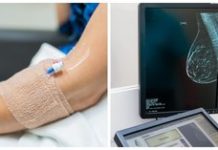Metastatic breast cancer is prevalent in the United States, with the National Cancer Institute estimating that about 168,000 American women were living with the disease in 2020. One of them was longtime NPR reporter Ina Jaffe. She had been diagnosed two years ago but was keeping it to herself. Now, she’s coming forward in part to help push more resources toward metastatic breast cancer research.
In a piece she wrote for NPR, Jaffe said she was initially diagnosed with stage 1B breast cancer in 2012. She had assumed that it was rare for women to progress to stage 4, but she learned otherwise.

She wrote, “Nope. Up to 30% of women with early stage breast cancer progress to stage 4. I thought that you were more likely to get metastatic breast cancer if you’d been diagnosed with a more-advanced stage of breast cancer to begin with. Wrong again. It’s not dependent on your stage at original diagnosis.”
She had already been aware that the five-year survival rate of stage 4 breast cancer was about 1 in 4, so upon her diagnosis, she privately grieved for her life. She had trouble eating and sleeping, and she spent much of her time crying.
She explained, “I’d been planning on becoming a really cool old lady. While covering aging for NPR, I’d met so many inspirational elders that I wanted to be one of them.”

While people faced with such a time-limiting diagnosis would typically be checking items off their bucket lists, Jaffe said that was pretty hard to do, given the pandemic. Her only excursions have been walks around her neighborhood.
She said, “Most people think of just writing this past year off and picking up again when everyone gets vaccinated, but that’s not easily done when you have a shorter timeline. You know there’s no way to ever make up for this year. Really, there’s no way to make up for lost time for any year.”
One thing she had plenty of time to do was reflect on the fact that such a limited amount of breast cancer funding goes toward the incurable metastatic form of the disease. She linked to a Metastatic Breast Cancer Alliance study noting that just 7% of the $15 billion invested in research between 2000 and 2013 within the North America and the United Kingdom went to stage 4 research.
Article continues below
Our Featured Programs
See how we’re making a difference for People, Pets, and the Planet and how you can get involved!
Other studies find that just 5% of such funding goes to metastatic breast cancer in Europe.
Jaffe said this caused her to become outraged, which was the largest motivating factor in sharing her diagnosis. With the deadly nature of the disease, she couldn’t understand how the figure could be so low.
She said, “Did I mention that this is the kind that kills you?”
Jaffe did note that for the time being, her only pain is from treatments. She also knows there are some patients who have been able to live for more than ten years with the disease, and there’s always hope that she could be one of them.

There’s more of a chance she could be than there would have been 30 years ago. The National Institute of Health says that the survival time for metastatic patients has been on the rise over the past few decades, particularly among younger women. A 2017 study found that the five-year survival rate for women diagnosed between the ages of 15 and 49 had increased from 18% in 1992-1994 to 36% in 2005-2012. During that same time stretch, women diagnosed between the ages of 50 and 64 had seen their average survival time increase nearly a year, from 19.1 months to 29.7 months. Researchers also noted that for women diagnosed between 2000 and 2004 when they were under the age of 64, more than 11% lived for ten years or more.
The hope is that with more funding and resources, those numbers can continue to increase… Or maybe, there could be a cure, and women with this diagnosis wouldn’t have to worry about timelines.
![]()
Provide Mammograms
Support those fighting Breast Cancer at The Breast Cancer Site for free! →
Whizzco Source







